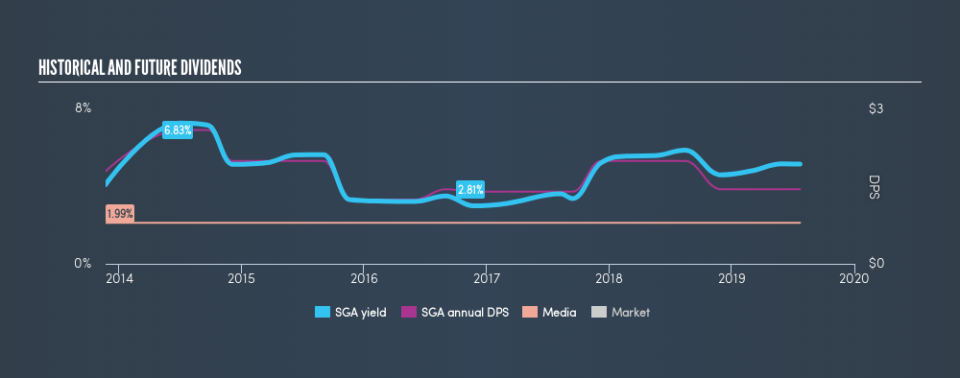Should Saga Communications, Inc. (NASDAQ:SGA) Be Part Of Your Income Portfolio?

Is Saga Communications, Inc. (NASDAQ:SGA) a good dividend stock? How can we tell? Dividend paying companies with growing earnings can be highly rewarding in the long term. If you are hoping to live on the income from dividends, it's important to be a lot more stringent with your investments than the average punter.
With a six-year payment history and a 4.8% yield, many investors probably find Saga Communications intriguing. It sure looks interesting on these metrics - but there's always more to the story . The company also bought back stock equivalent to around 1.1% of market capitalisation this year. Some simple analysis can reduce the risk of holding Saga Communications for its dividend, and we'll focus on the most important aspects below.
Click the interactive chart for our full dividend analysis
Payout ratios
Dividends are typically paid from company earnings. If a company pays more in dividends than it earned, then the dividend might become unsustainable - hardly an ideal situation. Comparing dividend payments to a company's net profit after tax is a simple way of reality-checking whether a dividend is sustainable. Looking at the data, we can see that 53% of Saga Communications's profits were paid out as dividends in the last 12 months. This is a healthy payout ratio, and while it does limit the amount of earnings that can be reinvested in the business, there is also some room to lift the payout ratio over time.
We also measure dividends paid against a company's levered free cash flow, to see if enough cash was generated to cover the dividend. Saga Communications paid out 20% of its free cash flow as dividends last year, which is conservative and suggests the dividend is sustainable. It's positive to see that Saga Communications's dividend is covered by both profits and cash flow, since this is generally a sign that the dividend is sustainable, and a lower payout ratio usually suggests a greater margin of safety before the dividend gets cut.
We update our data on Saga Communications every 24 hours, so you can always get our latest analysis of its financial health, here.
Dividend Volatility
Before buying a stock for its income, we want to see if the dividends have been stable in the past, and if the company has a track record of maintaining its dividend. Looking at the data, we can see that Saga Communications has been paying a dividend for the past six years. It's good to see that Saga Communications has been paying a dividend for a number of years. However, the dividend has been cut at least once in the past, and we're concerned that what has been cut once, could be cut again. During the past six-year period, the first annual payment was US$1.80 in 2013, compared to US$1.45 last year. This works out to be a decline of approximately 3.5% per year over that time. Saga Communications's dividend hasn't shrunk linearly at 3.5% per annum, but the CAGR is a useful estimate of the historical rate of change.
We struggle to make a case for buying Saga Communications for its dividend, given that payments have shrunk over the past six years.
Dividend Growth Potential
With a relatively unstable dividend, it's even more important to see if earnings per share (EPS) are growing. Why take the risk of a dividend getting cut, unless there's a good chance of bigger dividends in future? Over the past five years, it looks as though Saga Communications's EPS have declined at around 2.8% a year. Declining earnings per share over a number of years is not a great sign for the dividend investor. Without some improvement, this does not bode well for the long term value of a company's dividend.
Conclusion
To summarise, shareholders should always check that Saga Communications's dividends are affordable, that its dividend payments are relatively stable, and that it has decent prospects for growing its earnings and dividend. Saga Communications's payout ratios are within a normal range for the average corporation, and we like that its cashflow was stronger than reported profits. Earnings per share are down, and Saga Communications's dividend has been cut at least once in the past, which is disappointing. In sum, we find it hard to get excited about Saga Communications from a dividend perspective. It's not that we think it's a bad business; just that there are other companies that perform better on these criteria.
See if management have their own wealth at stake, by checking insider shareholdings in Saga Communications stock.
If you are a dividend investor, you might also want to look at our curated list of dividend stocks yielding above 3%.
We aim to bring you long-term focused research analysis driven by fundamental data. Note that our analysis may not factor in the latest price-sensitive company announcements or qualitative material.
If you spot an error that warrants correction, please contact the editor at editorial-team@simplywallst.com. This article by Simply Wall St is general in nature. It does not constitute a recommendation to buy or sell any stock, and does not take account of your objectives, or your financial situation. Simply Wall St has no position in the stocks mentioned. Thank you for reading.

